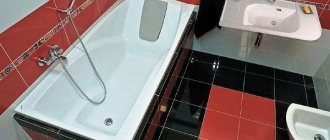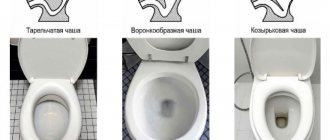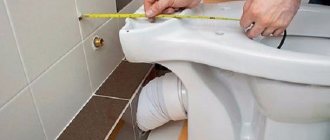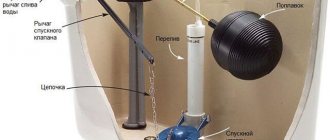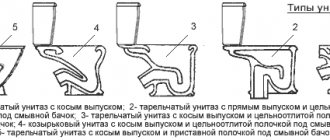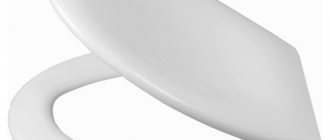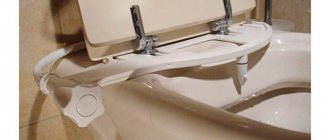It follows that the choice and purchase of a new toilet will affect everyone. In order to be prepared in advance for the purchase, you need to acquire knowledge about some of the factors that are taken into account when choosing this plumbing device. One factor is the height of the toilet.
On the floor or above the floor
Advertising brochures describing the advantages of wall-hung toilets contain the following main points:
- Hanging plumbing does not interfere with cleaning , leaving the entire floor area accessible.
- It makes a compact toilet spacious , allowing you to save space due to the tank.
- It allows you to completely hide communications , thereby improving the appearance of the bathroom.
Let's try to find out how much truth there is in marketers' statements.
Free floor
The statement is true without any qualifications. Installation - the frame to which the toilet is attached is hidden behind a false wall, leaving the entire floor area accessible.
This means that there will no longer be dark and damp places under the tank in your bathroom, that the base of the toilet will really not interfere with cleaning, and you won’t need to dismantle it to change the tiles. Not only that: the vacated floor will give more scope to your imagination when choosing a flooring pattern.
Cleaning just got easier.
Compactness
Console plumbing will really make the room more spacious, but only visually. The dimensions of a wall-hung toilet with a concealed cistern and installation are at least no smaller than the floor structure: due to the thickness of the false wall, they will most likely be somewhat larger.
Please note: the back wall of the toilet will move forward by about 20 centimeters, thereby making it impossible for you to use the space behind the toilet to create shelves or a small cabinet.
The actual dimensions of the toilet decreased noticeably after installing the wall-hung toilet.
Visual space will be associated with the characteristics of a person’s perception of the size of the room. They are unconsciously assessed by the area of two planes - the floor and the ceiling. Since the floor in our case is not cluttered, the toilet, despite the actual reduction in floor area, will seem somewhat less cramped.
By the way: mezzanines also visually make the room smaller. If you want to use part of the space of a small bathroom to store rarely used items, it is better to build a flat cabinet that covers the entire wall and equip it with mirrored doors.
Hidden communications
Yes, they will indeed be completely hidden. In addition to the toilet bowl, only the flush button will remain visible. Yes, it will be beautiful, but defiantly impractical.
You see, dear reader, the author of this article, over a decade of working as a plumber, became convinced that any structure sooner or later needs repair, be it a water supply system, a sewer system, a drain tank or a valve. Making communications difficult to access is guaranteed to create difficulties for yourself in the future. Even in 10 or 20 years.
Not only that: in a compact city apartment, the back wall of the toilet, which is usually hidden by a false wall along with the installation, is decorated with water supply and sewage risers. Even if you were not too lazy to first replace them with durable polymer or metal-polymer pipes, who can guarantee that they will not be damaged during a pressure surge? Or, as an option, will there be no need to replace a section of the riser in the ceiling (which is more than uncommon)?
Replacing risers in an apartment will not protect you from leaks in the ceiling.
Conclusions? Everyone will make them for themselves. Let's just say: the author never once had the thought of choosing something other than a classic floor design.
Height Standards
Over more than a century of history in the production of plumbing equipment, certain standards have been developed regarding the size and installation height of toilets. These figures directly depend on the average height of a person - an indicator that is slowly but surely changing upward. That is why every decade the standard toilet height increases by several millimeters.
The dimensions and height of the toilet installation are shown in the following figure.
Floor
Thus, the standard height of a floor-standing toilet that existed in recent years - 40 cm, is already giving way to a more modern standard - 42 cm. And in some countries, the population of which is made up of especially tall people, toilets of half a meter in height have begun to be produced.
Before choosing, try different options and choose the best one for your height.
Suspension
For wall-hung toilets the numbers will be different. The main thing here is to take into account the distance from the floor level to the bottom edge of the toilet. Ideally it should be 20 cm.
It should be borne in mind that if, after installing the toilet, the installation of the finishing floor covering follows, this distance will be reduced and the position of the toilet will be inconvenient.
Dimensions and distances
Are you scared by the criticism of the decision we are discussing? Well, let's move on to the next stage.
The size of a wall-hung toilet and its installation varies depending on the manufacturer and model within a fairly wide range.
| Dimensions | Value, mm |
| Length (from wall) | 500 – 600 |
| Width | 300 – 400 |
| Bowl height | 300 – 400 |
| Installation depth | 150 – 300 |
| Installation height | 800 – 1400 |
| Installation width | 500 – 600 |
At what height should a wall-hung toilet be attached to the wall? Optimal values lie in the range of 400 – 450 millimeters.
Dimensions and installation recommendations from one of the plumbing manufacturers.
As always, there are a number of nuances.
- Don't forget about the thickness of the seat. Having set the edge of the toilet to a height of 450 mm and installed the seat, you may find that the height has become uncomfortably high.
- The height is selected based on the level of the finished floor covering. If you position the toilet so that its edge is 400 mm from the floor, and then fill the screed and lay the tiles, you will have hearing problems when visiting the toilet. Your ears will be covered with your knees.
- Finally, if the height of your family members differs significantly from the average in one direction or another, the height of the wall-hung toilet can be adjusted accordingly.
Do not forget about the location of the plumbing item in the room.
- Distance from the edge of the bowl to the wall, bidet, washing machine, etc. ideally should not be less than 20 centimeters. The distance to these objects from the longitudinal axis of the bowl should not be less than 40 cm.
- A reasonable minimum distance from the front edge of the seat to the door is 60 cm. No, a closer door won’t hurt to sit down, but adjusting your clothes will do the trick.
Placing the toilet in the toilet room.
- The optimal height of the drain button is about a meter from the floor.
Types of toilets
The height will depend on the type of toilet.
Based on mounting methods, toilets are divided into the following types:
- Floor-standing
Today this model is installed in most bathrooms. This is a standard toilet that consists of a bowl-shaped base and a flush cistern attached to it. It is installed on the floor, and the bowl itself acts as a stand.
- Hanging
This type of toilet is more modern and is not yet installed very often. Often found in bathrooms that are located in crowded places, for example, restaurants, shopping centers, sports clubs. They are attached to the wall above the floor using a rigid frame, which serves as a holding structure. As for the cistern, it is often located behind a false wall.
Bowl shaped
Funnel-shaped bowl. There are no protrusions inside such a bowl , which facilitates the immediate entry of sewage into the drain, which is located only horizontally.
But there is one very significant disadvantage - splashing water when rinsing. Plate-shaped bowl. Inside this bowl there is a ledge with a slight depression - it is into this that all the impurities initially fall, and then into the drain. The downside is the frequent need to use a brush, as well as the high consumption and splashing of water when rinsing.
Visor bowl . The shape of the bowl is slightly similar to the dish-shaped one, but the recess in the ledge is replaced by a small tubercle. Consequently, sewage does not tend to accumulate in the bowl; it rolls down into the drain itself. And also when rinsing, water does not splash.
By release type
- Oblique outlet - this model is necessary if the sewer socket is close to the floor level.
- Horizontal outlet - must be purchased if the sewer socket is located at a height of 5 to 10 centimeters from the floor level.
- A vertical outlet is indispensable when the sewer socket is located far from the wall to which the toilet is mounted.
Useful tips
Let us allow ourselves to give the reader some advice on the selection and installation of the plumbing fixtures that interest us.
Choice
Like floor-mounted, wall-hung toilets can be made from different materials. Let's try to evaluate them.
Polished stainless steel is virtually stain-free due to its exceptionally smooth surface. If deposits still remain on it, they can be easily removed using any household chemical.
Material – stainless steel.
Why does stainless steel occupy a much smaller market share than competing solutions?
There are two reasons:
- Somewhat official-looking steel plumbing fixtures. It has become familiar as anti-vandal equipment for public toilets and evokes corresponding associations among most potential buyers.
- In addition, the price of stainless steel toilets is much higher than that of ceramic analogues, and starts from about 20,000 rubles.
Glass is not much inferior to stainless steel in practicality; however, looking through the translucent walls at what remains on the walls of the bowl below the water level is a rather dubious pleasure.
Sediment and dirt will be too visible in a glass toilet.
The main problem of polymer concrete is its limited resistance to aggressive cleaning agents and scratches. Removing urinary stone and lime deposits from it without disturbing the appearance of the surface is a non-trivial task.
The main value of sanitary ware is its low cost. That is why it is the undoubted leader in the plumbing market. The disadvantage is that its large-porous surface actively collects dirt and often needs cleaning.
Glazed faience, thanks to its glassy coating, is much more resistant to stains and is easier to find, practically no different in cost from material without glaze.
Finally, the optimal material for the combination of cost and functionality is porcelain. The walls of the toilet will remain snow-white for a long time; If the need for cleaning does arise, you can safely use acidic and alkaline preparations.
Porcelain stays clean longer.
Installation
Are there any subtleties to installing a wall-hung toilet yourself?
The installation stages themselves are comprehensively described in the accompanying documentation:
- The location of the installation frame is marked by level or plumb.
- It is anchored to the wall and/or floor.
- Water is supplied to the tank, and a sewer pipe is supplied to the location of the toilet flare.
- The hole in the tank for the drain button is closed with a special membrane or ordinary polyethylene, after which the installation and communications are hidden by a false wall. As a rule, it is assembled from moisture-resistant plasterboard along a galvanized profile and laid out with tiles.
- After the tile has firmly set, the toilet is hung on the studs of the installation, and a flush button is installed in the tank. A damper gasket is required between the toilet and the wall, distributing the load on the tile and preventing chips from appearing.
The silicone gasket is clearly visible in the photo.
By the way: in the absence of a gasket, silicone sealant can play its role.
There are a few nuances here:
- It is better to start laying the tiles from the drain button, so that the seams are located symmetrically relative to the center of the button. Asymmetry doesn't look very neat.
- The shorter the sewer line to the riser, the less likely it is to become clogged. Don’t forget about the slope: for pipes with a diameter of 90 and 110 mm used for hidden installation, it is 2 cm per linear meter.
- It is better to collect the sewerage using sealant. The instructions are due to the fact that rubber seals may lose their elasticity over time and leak.
- Forget about flexible eyeliners. Water is supplied to the tank by a rigid pipe. The service life of a braided rubber hose rarely exceeds 5 years.
- Despite the fact that the fittings of the tank usually allow you to shut off the water through the service hatch behind the drain button, it is better to provide the supply to the tank with a valve and leave a hatch in the false wall for access to it.
Through the hatch it is easy to reach the valves that shut off the water.
Selection process
In order to choose a toilet model that will be comfortable for all members of your family to use, you need to understand several important nuances:
- Price . Depending on the cost, three types of toilets can be distinguished: budget models (usually these include products from domestic manufacturers); models in the middle price segment (as a rule, these are products of Turkish, Czech, Polish manufacturers); luxury models (Swiss, Austrian and German production).
- Height. Everyone in your household should be involved in choosing the height of the toilet. Sit on the model you like: if you are comfortable, your feet touch the floor, and your muscles are relaxed, then this height is suitable for you.
- Flush type. Based on this feature, toilets with direct and circular flush are distinguished. In models of the first type, water moves only in one direction when flushing; this type of flush is considered more economical in terms of water consumption. In models with a circular flush, the toilet bowl is washed with water in two directions, which provides a more thorough cleaning.
- Material. Today, a variety of materials are used to make toilets: plastic, artificial stone, cast iron, steel, porcelain and earthenware. The most modern and the most favorable in terms of price-quality ratio are the last two options.
No splashing
Water splashes very often interfere with the comfortable use of the toilet, not to mention the fact that this phenomenon is very unhygienic. Toilet manufacturers offer a variety of solutions to this problem. Toilet models with an anti-splash system are one of the relatively new engineering developments.
“Anti-splash” is a design feature of the toilet, which is designed to compensate for splashes that occur during its operation. Labeling about the presence of this system often deceives the buyer. To determine the presence of “anti-splash” yourself, look into the bowl of the toilet model you like. To suppress water movement, the drain hole should be very narrow and located as low as possible. Also make sure that the drain hole is offset from the center and that the water level in it is low enough. The drain hole should be surrounded by a special rim. If all these factors are present, then you have a toilet model equipped with an anti-splash system.
Installation features
You can only say specifically how to install a hygienic shower for a toilet on the spot. There are too many different nuances that are simply impossible to take into account. The connection principle is simple: you supply cold and hot water to the corresponding inputs. That's all. How to do this, with pipes or flexible hoses, is your choice. Of course, pipes are more reliable, but high-quality flexible hoses in good braid can last for years.
There is only one nuance that is worth remembering. When connecting a hygienic shower to hot and cold water (centralized system), be sure to install ball valves and check valves. Taps are almost always installed, but check valves are often forgotten.
This is a check valve. During installation, turn it so that the arrow on the body coincides with the direction of water flow
They are needed so that water from the “cold” riser does not mix with hot water and vice versa. Usually, just the opposite happens - you open cold water, and boiling water pours out, but the opposite cases also happen - hot water periodically becomes not hot at all. This is all because someone did not install a check valve on your riser when connecting a hygienic shower to the toilet.
The tap is opened, the shower is not being used yet, and through the open mixer water from one riser is mixed into another. Which water goes where depends on where the pressure is higher. Usually higher in hot risers (almost twice), which is why such cases are more common. But cold addition is also possible. In general, do not forget to install shut-off valves. They cost mere pennies (compared to the cost of the equipment), but they prevent unpleasant situations and disputes with the operating company and “happy” neighbors.
No splashing
Water splashes very often interfere with the comfortable use of the toilet, not to mention the fact that this phenomenon is very unhygienic. Toilet manufacturers offer a variety of solutions to this problem. Toilet models with an anti-splash system are one of the relatively new engineering developments.
“Anti-splash” is a design feature of the toilet, which is designed to compensate for splashes that occur during its operation. Labeling about the presence of this system often deceives the buyer. To determine the presence of “anti-splash” yourself, look into the bowl of the toilet model you like. To suppress water movement, the drain hole should be very narrow and located as low as possible. Also make sure that the drain hole is offset from the center and that the water level in it is low enough. The drain hole should be surrounded by a special rim. If all these factors are present, then you have a toilet model equipped with an anti-splash system.
Height Standards
Over more than a century of history in the production of plumbing equipment, certain standards have been developed regarding the size and installation height of toilets. These figures directly depend on the average height of a person - an indicator that is slowly but surely changing upward. That is why every decade the standard toilet height increases by several millimeters.
The dimensions and height of the toilet installation are shown in the following figure.
Floor
Thus, the standard height of a floor-standing toilet that existed in recent years - 40 cm, is already giving way to a more modern standard - 42 cm. And in some countries, the population of which is made up of especially tall people, toilets of half a meter in height have begun to be produced.
Before choosing, try different options and choose the best one for your height.
Suspension
For wall-hung toilets the numbers will be different. The main thing here is to take into account the distance from the floor level to the bottom edge of the toilet. Ideally it should be 20 cm.
It should be borne in mind that if, after installing the toilet, the installation of the finishing floor covering follows, this distance will be reduced and the position of the toilet will be inconvenient.
Plumbing with non-standard bowls
The previously developed standards satisfied the needs of the average European person. Over the past few decades, the height of people has increased, so appropriate adjustments have been made to ensure comfortable use of plumbing fixtures. Over 130 years, the height of the average person has increased by 15 cm , and the distance from foot to knee - by 6 cm . The current standards are not suitable for everyone, so for comfort in the toilet room, non-standard models with a high or low bowl are used.
A tall (royal) toilet is an ideal solution for people who are dissatisfied with the mass supply on the plumbing market.
Unlike the standard height, here the bowl is located at a level of 46-50 cm from the floor. Comfort for tall people is guaranteed. As a rule, the bathroom is complemented by a sink and furniture of non-standard sizes.
An excellent option is the Kolo Nova Pro M39045000 compact toilet with a bowl height of 460 mm and a total of 845 mm .
Low models are used in the opposite case. People with short stature or limited mobility reduce the distance between the floor and the bowl to protect themselves and ensure a comfortable environment in the bathroom.
This option is also suitable for saving space. As an example, you can use the Spanish plumbing fixtures ROCA Gap A34947800W with a height of 385 mm .
Height of toilets with a tank from the floor: norms up to 70 cm
When choosing models with a tank, you should pay attention not only to the height of the bowl, but also to the size of the entire structure. Correctly selected parameters help to facilitate the repair process and better think through the design of the room. For example, a boiler is often installed above a plumbing product, and in order to combine both devices, you need to know the dimensions in advance .
Standard parameters on the Russian market:
- width - 350-380 mm ;
- length - 620-600 mm ;
- height - 700-730 mm .
Photo 2. Turkish compact toilet IDEVIT Alfa Rimless SETK3104-0315-001-1-6200 with a height of 89.5 cm.
Tall models are, in most cases, used in bathrooms with a lot of free space. The devices are characterized by an increased distance from the floor to the bowl, the overall size of the structure and width. The height of non-standard products starts from 77 cm . As a rule, manufacturers do not create toilets higher than 90 cm , but there may be exceptions. As an example, you can pay attention to the Turkish compact toilet IDEVIT Alfa Rimless SETK3104-0315-001-1-6200 with a height of 89.5 cm .
Low models are also in demand. Compact products are purchased when it is necessary to save space in all planes. The distance from the floor to the top of the tank is up to 69 cm . Models from some manufacturers may be lower, up to 60 cm . For example, the ROCA Inspira Square A342537000 together with the tank occupies only 64.5 cm .
Important! It should be taken into account that for non-standard toilets the height of the bowl has been changed up or down.
Dimensions of built-in high toilets: what should they be
Hanging models have been in great demand lately. This is due to the aesthetics and ease of maintenance of the device.
to install the installation during a rough renovation , because it requires the installation of a special box or hiding plumbing communications in the walls. In this case, the tank is hidden, and all you see is the bowl and the button mounted on the wall. Standard parameters:
- width - 350-370 mm ;
- depth - 480-700 mm ;
- height - 500-600 mm .
In addition to standard dimensions, the installation height should be taken into account. The metal structure occupies from 110 to 130 cm . Therefore, the option is not suitable for bathrooms with limited space.
Important! Installations are recommended to be used only if the rough plumbing can be hidden in a wall or false box .
There are also non-standard installations, the height of which reaches up to 130 cm . In this case, it is almost impossible to place anything above the structure. The distance from the floor can only be adjusted using specific bowl designs.
Reference! When choosing a built-in bowl, consider the distance between the mounting bolts. As a rule, two main sizes - 15 or 18 cm .
Technical conditions for good installation
- The release of a new toilet must be the same as the release of an old one, otherwise you will need to carry out extensive work related to construction.
- Calculate the distance from the toilet cistern to the cold water supply point. Water is supplied using special flexible hoses.
- If your outdated toilet was built into the floor and secured with cement, after removing it, clean the screed residue from the floor base before installing the new toilet.
- Installation rules differ for different toilet models, and therefore we advise you to definitely follow the installation instructions provided by the manufacturer.
https://youtube.com/watch?v=pGDenqlEpkI
Selection process
In order to choose a toilet model that will be comfortable for all members of your family to use, you need to understand several important nuances:
- Price . Depending on the cost, three types of toilets can be distinguished: budget models (usually these include products from domestic manufacturers); models in the middle price segment (as a rule, these are products of Turkish, Czech, Polish manufacturers); luxury models (Swiss, Austrian and German production).
- Height. Everyone in your household should be involved in choosing the height of the toilet. Sit on the model you like: if you are comfortable, your feet touch the floor, and your muscles are relaxed, then this height is suitable for you.
- Flush type. Based on this feature, toilets with direct and circular flush are distinguished. In models of the first type, water moves only in one direction when flushing; this type of flush is considered more economical in terms of water consumption. In models with a circular flush, the toilet bowl is washed with water in two directions, which provides a more thorough cleaning.
- Material. Today, a variety of materials are used to make toilets: plastic, artificial stone, cast iron, steel, porcelain and earthenware. The most modern and the most favorable in terms of price-quality ratio are the last two options.
Which to choose?
The width of the sofas is standard. What are the standard sofa sizes? what is the standard height of a sofa from the floor
There are two main types of toilets: floor-mounted and wall-hung. From the name you can understand that these types of toilets differ in the installation method. The floor-mounted toilet has a relatively low cost and is very easy to install. In addition, it is easy to maintain, because all the necessary components are always available for sale
The advantages of a wall-hung toilet include accessibility of the entire area, which is very important when cleaning the bathroom. Also, when installing such a toilet, all communications are hidden in the wall and do not spoil the appearance of the room, as is the case with floor-standing toilets
The last point at the same time complicates the maintenance of such a toilet, because getting to the structure becomes much more difficult if it is walled up in the wall.
If we talk about the installation height, then with a floor-standing toilet, of course, no questions arise, since it already has a fixed height and all that can be done is to place it on a pedestal. But when installing a wall-hung toilet, you need to comply with some standards prescribed by the specific features of use. In order to understand the principle of correct installation, you need to study the communications structure of a wall-hung toilet.
Installation


